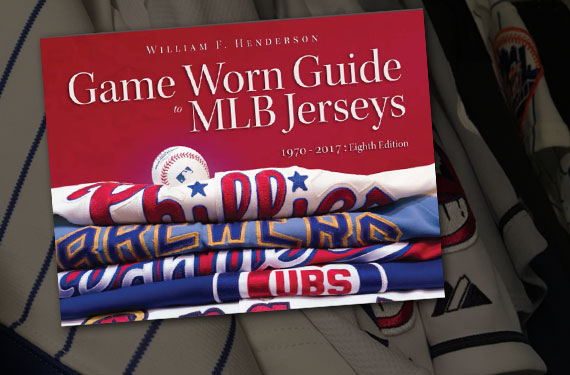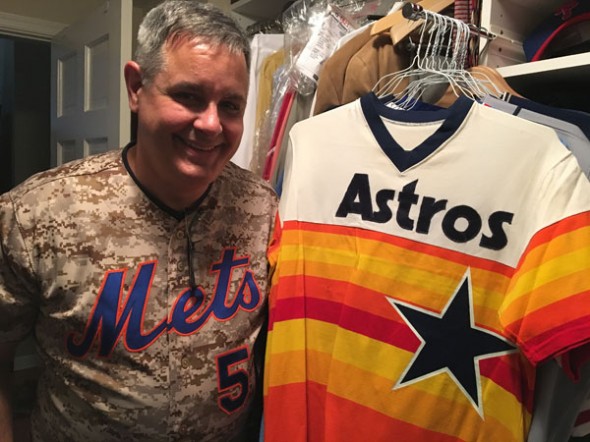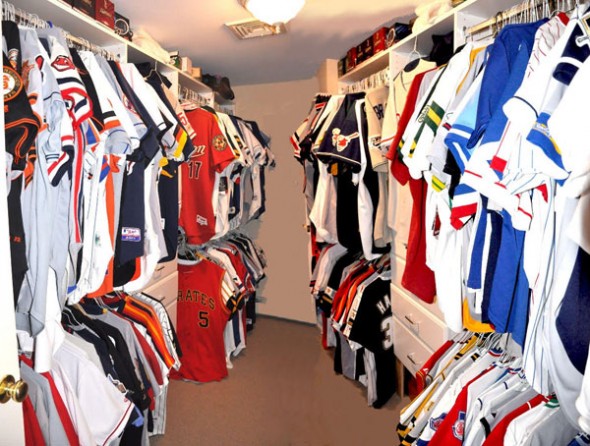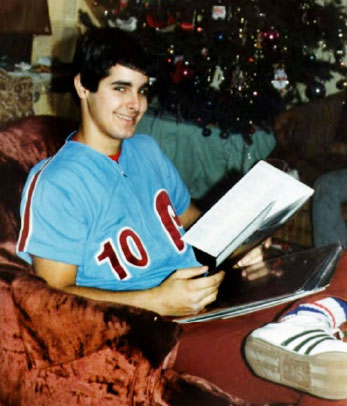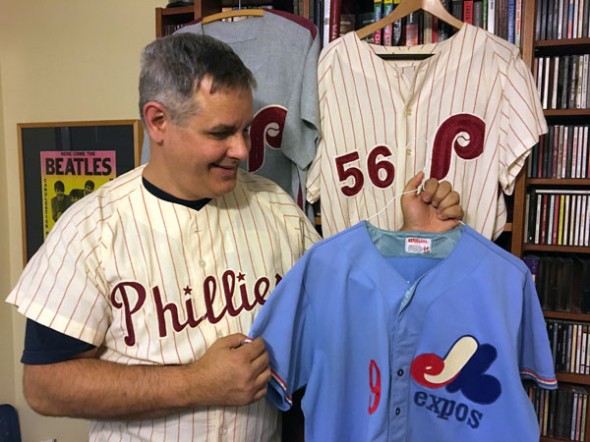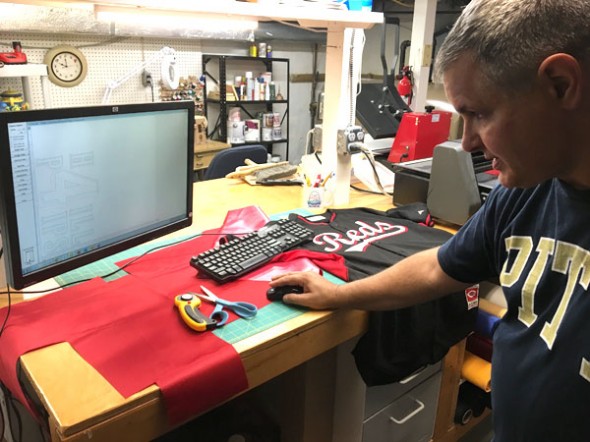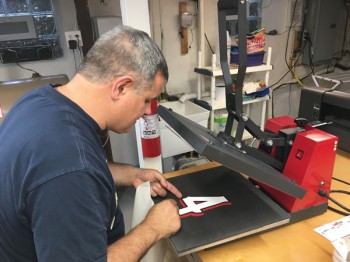Bill Henderson, author of the Game Worn Guide to MLB Jerseys, answers his front door on a rainy Saturday afternoon wearing a camouflage New York Mets jersey tucked into jeans. It’s a bit startling because I know two things about Bill: He does not like specialty jerseys and he is a Phillies fan. A camo Mets jersey was the last thing I was expecting.
Over the course of the next hour, Henderson introduces me to his collection of authentic, not-so-authentic, and restored Major League Baseball jerseys. There are roughly 1,000 by Henderson’s count—nearly every home, road, alternate, and batting practice jersey for every Major League team since 1972. There’s an entire closet just for Padres jerseys.
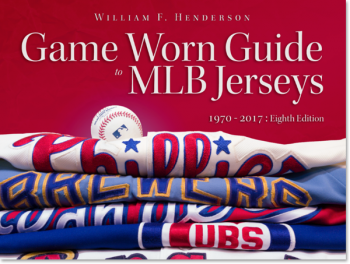 The Game Worn Guide to MLB Jerseys, Henderson’s labor of love since the 1970s, is an electronic book dedicated to the minutiae of identifying, restoring, and collecting authentic baseball jerseys. The book’s origins coincide with the early days of Henderson’s collection. It began simply as a series of notes he kept for himself so that he could differentiate between authentic jerseys and knock-offs. The most recent version, the eighth edition, available on Henderson’s website (and nowhere else because it’s so huge), weighs in at 3,600 pages.
The Game Worn Guide to MLB Jerseys, Henderson’s labor of love since the 1970s, is an electronic book dedicated to the minutiae of identifying, restoring, and collecting authentic baseball jerseys. The book’s origins coincide with the early days of Henderson’s collection. It began simply as a series of notes he kept for himself so that he could differentiate between authentic jerseys and knock-offs. The most recent version, the eighth edition, available on Henderson’s website (and nowhere else because it’s so huge), weighs in at 3,600 pages.
“When I started looking for game-worn uniforms, I started making a list of what was correct and what was incorrect,” Henderson said. “A lot of times you’d be able to find some surplus stuff that was unlettered … and I wanted to know what lettering to put on them. So often, I would get them done and they’d be wrong. They’d have the wrong color numbers on them, they’d have the wrong style, they’d have the wrong thicknesses of outlines. I realized that nobody had any record of this, so I started making a record.”
This record grew with each passing season, and soon fans and fellow collectors took notice.
“People started asking for copies,” Henderson said. “It got to be 100 pages, and then it got to be 300 pages. I don’t think it was really until the third edition of this that I started marketing it.”
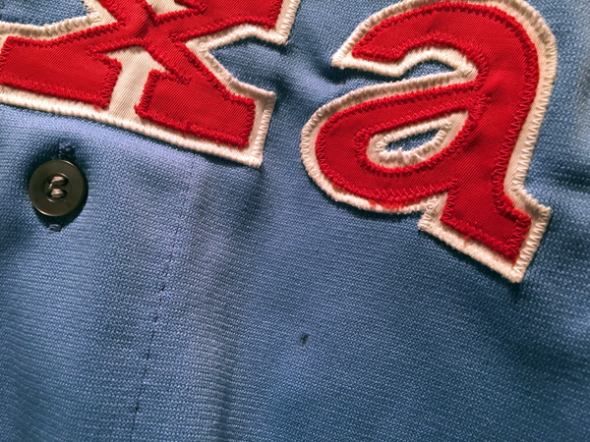
In the beginning, Henderson started collecting, documenting, and writing about game-worn jerseys as a way to connect to the game he loves.
“I was not a good player, so my connection to the sport was the uniforms,” he said. “Uniform means you belong.”
Some items from the collection have unique, personal stories. One of the prized items in the collection is a powder blue Gaylord Perry Texas Rangers jersey complete with holes from cigarette burns (pictured above). During my visit, Henderson took out the jersey and showed how Perry would shield cigarettes from view as he smoked, which caused ashes to fall on his jersey.
The first jersey Henderson acquired was that of his favorite player, Larry Bowa. A photo of Henderson wearing his Bowa jersey in 1980 (left, above) appears in his book. Also pictured in the book is a photo of that jersey in its current home, autographed by Bowa and safely housed in a shadow box along side a Mike Schmidt jersey, some ticket stubs, and a Phillies pennant.
Henderson’s collection doesn’t languish unused in storage. He wears the jerseys as part of his everyday wardrobe. Showing me a 1960 Phillies jersey (pictured above), Henderson proudly tells the story of the collector he bought it from who was baffled when Henderson asked him about cleaning instructions. Why, the collector asked, would you need cleaning instructions? It’s already clean. Yeah, Henderson replied, but it won’t be when I wear it!
“If I don’t take these out of the closet and wear them, I never see them,” Henderson explained. “I’ll just reach in here and grab one, and whatever I grab that day is what I wear.”
In his basement, Henderson maintains a shop where he restores damaged original jerseys or corrects flawed imitations to reflect the appropriate lettering or styles. Font patterns stored on a computer guide a mechanized cutting machine, which produces letterforms that Henderson layers and presses by hand before stitching them on to jerseys.
This hands-on knowledge helps inform an intricate level of detail in the pages of the Game Worn Guide.
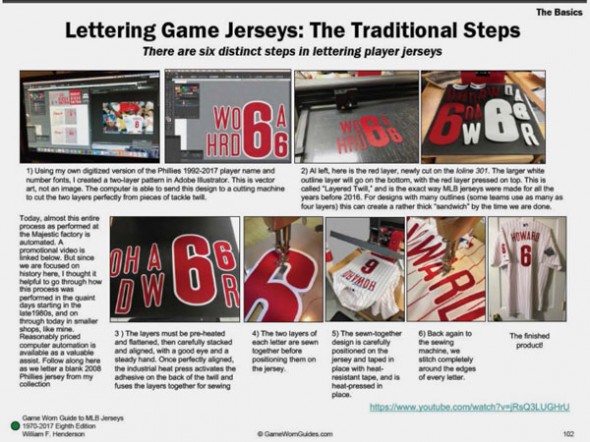
Henderson’s expertise has become so widely recognized that MLB teams consult with him to make sure their throwback jerseys are accurate.
“I have a great relationship with the front offices of several teams as well as the baseball Hall of fame in Cooperstown,” he said. “My research is on file there as a part of their permanent research collection.” (Henderson showed me a recent letter from the Hall of Fame’s library director saying how valuable the museum’s curators have found his book and asking if he would donate a copy of the new edition.)
Of course, Henderson’s intimate knowledge of uniform designs over the past four decades is both a blessing and a curse.
“It thrills me when I see my recreated team artwork in use on the field, as I have recently with the Astros and Mariners, who used my patterns,” he said. “Conversely, it makes me sad when a team fields uniforms that are inaccurate, when I am so able and willing to help them get it right.”
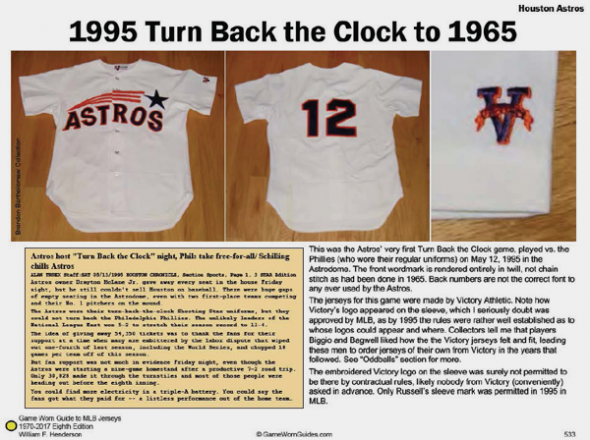
As Henderson’s reputation and the circulation of his book expand—he estimates that the last edition of his book sold about 1,500 copies—readers contact him not only with questions or requests, but to help augment the content in the book.
“I had one collector this edition who collects only Turn-Back-the-Clock jerseys from every team,” Henderson said, “and he filled in many holes where before we lacked good close-up photos of game jerseys laid flat.”
Looking ahead, Henderson is considering options for his publication, including attempting to document jerseys from the 1950s and ’60s, though he hesitates when he considers how difficult researching those decades would be. For right now, he’s content to maintain his remarkable collection of jerseys—just for wearing around—and to provide a resource that has become invaluable to fans, collectors, designers, and Major League Baseball itself.
Discount for SportsLogos Readers
Bill Henderson has offered reader of this site a discount on the just-released current version of the book. Use the code SportsLogos (case sensitive) to get 25 percent off at checkout. Visit gamewornguides.com.

